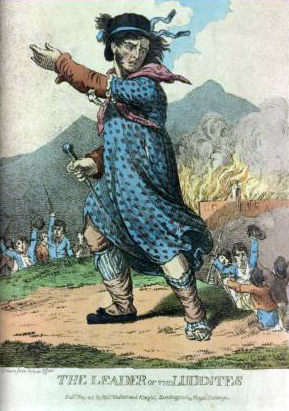The industrial revolution brought about significant changes to peoples lives as they knew them. The machines introduced by the industrial revolution made huge profits for the factory owners but snatched away the livelihoods of others. Skilled textile workers of the domestic system for example hand loom weavers lost considerable amounts of their work as steam-powered looms were used as a replacement. As a result of this wages were cut and opportunities for them to earn a living became one dimensional. They had to conform to industrialisation.
Although specific dates vary unrest towards the industrialisation began to manifest between 1811-1816 when textile workers in the Midlands, Yorkshire & Lancashire began to fight back against the factories and the mass change which was occurring. This fight back consisted of groups of workers who would attack factories by burning and smashing machines which had driven them the edge of starvation.
These workers were said to be following a mythical leader known as ‘General Ludd’ and destroyed the machinery they were employed to operate. The movement was strategically organised into groups or factions each with a specific industrial objective dependant on the type of industry was local to them. Those within the Luddites movement in Lancashire for example would target power looms.
The Luddites attack didn’t just consist of destroying machines however. Things became more serious as bosses of the factories commonly received threats to both themselves and their families; some were even murdered! Concern grew everyday with the Luddites. The leader also known as Ned Ludd or ‘King’ Ludd was still mysterious and unknown to the authorities.
Ned Ludd the leader of the Luddites would send letters to mill owners declaring his intentions. This was an incredibly scary time for the owners of these Mills and workers. A letter to a mill owner in Huddersfield suggested Ned would send one of his lieutenants with at least 300 men and destroy shearing frames and burn them to ashes.
The authorities were incapable of stopping the attacks so the government felt obliged to put in place special legislation. Machine-breaking had previously been made a capital offence in 1721. It wasn’t until 1811 a special Act was passed to secure the peace of Nottingham. At the Nottingham Assizes in March 1812, seven Luddites were sentenced to transportation for life; two others were acquitted.
Troops were typically called to places where Luddites would commonly attack and were either scared off or arrested. Due to the new act transportation or even execution occurred. Seventeen machine-breakers were executed at York in 1812 and others transported permanently to Australia.
The Luddites destruction continued with attacks on the Heathcote and Boden’s mill in Loughborough and William Cartwright’s mill at Rawfolds near Huddersfield. This was actually mentioned by Charlotte Bronte in her novel ‘Shirley’.
These attacks and subsequent violence subsided until around 1816 where there was a bad harvest and the attacks revived. On 28 June the Luddites attacked Heathcote and Boden’s mill in Loughborough, smashing 53 frames at a cost of £6,000. More executions occurred as well as transportation to Australia.
Although the Luddites movement began to diminish due to the government force the urban Luddite movement found a rural echo in 1830 when due to low wages and unemployment the ‘Swing’ riots began. This again was led by a mythical leader in ‘Captain Swing’. Threshing machines were destroyed which were said to take away winter employment and wages. This movement only lasted a few months however as due to the experience of the Luddites attacks the government were quick in action. The actions were even more brutal with 19 death sentences carried out.
These anti establishment and anti industralisation groups were forced away. A more civil approach was required in the shape of trade unions. Something we still see today,
Sources:
http://www.historyhome.co.uk/c-eight/distress/luddites.htm
All About the Industrial Revolution – Peter Hepplewhite & Mairi Campbell
How The Industrial Revolution Changed the world – Thomas Crump
